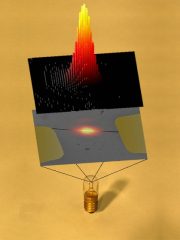World’s smallest light bulb created at UCLA
 It’s actually so small that even the researchers had to publish an artist rendering of the light bulb instead of a real photo. Besides other usages it will help in an effort to explore the boundary between thermodynamics and quantum mechanics – two fundamental yet seemingly incompatible theories of physics. The world’s smallest glowing bulb was made by a team from the UCLA Department of Physics and Astronomy has created. The team, which is led by Chris Regan, has published the results of their research in the online edition of the journal Physical Review Letters.
It’s actually so small that even the researchers had to publish an artist rendering of the light bulb instead of a real photo. Besides other usages it will help in an effort to explore the boundary between thermodynamics and quantum mechanics – two fundamental yet seemingly incompatible theories of physics. The world’s smallest glowing bulb was made by a team from the UCLA Department of Physics and Astronomy has created. The team, which is led by Chris Regan, has published the results of their research in the online edition of the journal Physical Review Letters.
Thermodynamics, the crown jewel of 19th-century physics, concerns systems with many particles. Quantum mechanics, developed in the 20th century, works best when applied to just a few. The UCLA team is using their tiny light bulb to study Planck’s black-body radiation law, which was derived in 1900 using principles now understood to be native to both theories.
Planck’s law describes radiation from large, hot objects, such as the Sun or a light bulb. Some such radiation is of fundamental and current scientific interest; the thermal radiation left over from the Big Bang, for instance, which is called the cosmic microwave background, is described by Planck’s law.
Their tiny light bulb utilizes a filament made from a single carbon nanotube that is only 100 atoms wide. To the unaided eye, the filament is completely invisible when the lamp is off, but it appears as tiny point of light when the lamp is turned on. Even with the best optical microscope, it is only just possible to resolve the nanotube’s non-zero length. To image the filament’s true structure, the team uses an electron microscope capable of atomic resolution at the Electron Imaging Center for Nanomachines (EICN) core lab at CNSI.With less than 20 million atoms, the nanotube filament is both large enough to apply the statistical assumptions of thermodynamics and small enough to be considered as a molecular — that is, quantum mechanical — system.
“Our goal is to understand how Planck’s law gets modified at small length scales,” Regan said. “Because both the topic (black-body radiation) and the size scale (nano) are on the boundary between the two theories, we think this is a very promising system to explore.”
The carbon nanotube makes an ideal filament for this experiment, since it has both the requisite smallness and the extraordinary temperature stability of carbon. While the intensive study of carbon nanotubes only began in 1991, using carbon in a light bulb is not a new idea. Thomas Edison’s original light bulbs used carbon filaments.
The UCLA research team’s light bulb is very similar to Edison’s, except that their filament is 100,000 times narrower and 10,000 times shorter, for a total volume only one one-hundred-trillionth that of Edison’s.
This breakthrough comes at a time when inventors are moving away from the usage of common light bulbs and even looking beyond the environmentally friendlier compact fluorescent bulbs (CFLs), and trying to figure out how to make LED lights cheap enough to take over the job of lighting homes and offices.
The invention is aiming to help the scientists in order to have a better understanding on the potential relation between the physics of large things and the physics of particles. If no lights went on for you there, be comforted by the thought that all this bears on the anticipated “theory of everything” which would, if discovered, help our understanding of gravity and how the universe works.










Leave your response!